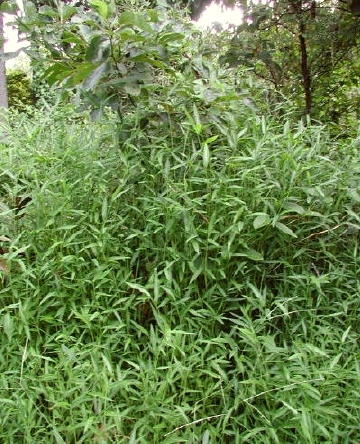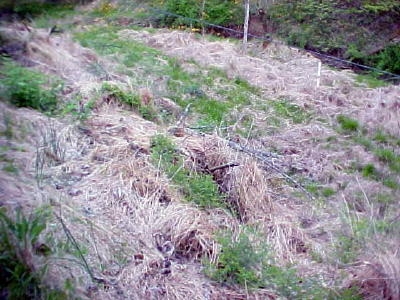STILT GRASS DESTROYING FOREST LIFE - Calhoun Workshop Tomorrow


The invasion of Japanese Stilt Grass in the woods and forests of Calhoun County and nearly all of West Virginia, is becoming a primary concern of forestry experts, biologists, loggers, scientists and land owners.
A workshop about the toxic stilt grass is scheduled for tomorrow at Russ Richardson's Tree Farm on the Right Fork of Crummies Creek, with several dozen professionals and concerned groups attending the event.
The general public can register for the workshop.
Richardson, who is a forester, says the rapid growth and climbing nature of this exotic invasive grass has the potential to cause an ecological disaster. The invasive plant has been found in many sections of Calhoun for eight years.
The grass could eventually destroy the forest - trees, herbs, plants and flowers.
"It could be the likes of which the Appalachian hardwood forest may never recover," said Richardson, making multi-flora rose look like a minor problem.
Richardson said last year's ice storm opened up a lot of sun light to help the seeds grow, in addition to a large amount of rainfall in 2003 and a good growing season. It also tends to grow in areas that have been recently logged.
The grass grows six to eight feet tall, then dies on the ground to smother its victims. Because it has a faint root system, it moves or washes away easily.
The workshop will include opportunities to control the grass, starting at 9:30 a.m. at Richardson's Tree Farm on the Right Fork of Crummies Creek. Directions to the workshop:
LOCATION: 1.4 MILES EAST OF WV 16, ON CALHOUN COUNTY ROUTE 16/25, (RIGHT FORK, CRUMMIES CREEK ROAD) 2.3 MILES SOUTH INTERSECTION OF WV ROUTE 16 AND US 33/119 IN ARNOLDSBURG. (ALSO, 1.4 MILES OFF WV 16, ABOUT 16.5 MILES NORTH OF I 79 EXIT 40.) Once you leave WV 16 bear to the right, crossing a low water bridge about 7/10 of a mile from WV 16 and follow Right Fork Road to the meeting point.
General Overview:
The intention of the program is to show foresters and natural resource managers how to recognize, evaluate and potentially treat populations of invasive plants that are beginning to impact natural regeneration and forest under story vegetation. Morning session will include defining Invasives, how different problem organisms spread, how the arrival of new threats is escalating and opportunities for containment.
There will also be a demonstration of Japanese stilt grass (Microstegium vimineum) spread, control, and treatment options, including the impact of fire on Microstegium germination. Afternoon session will take place in a fertile cove site severely impacted by the 2003 ice storm where salvage logging has taken place. Afternoon topics will include: spread of Microstegium within the forest and the developing environmental impact of Microstegium, recovery of the forest from the 2003 ice storm and current forest health issues in ice storm impacted areas.
The program is sponsored by the Crummies Creek Tree Farm, WV Division of Forestry, WVU Extension, Woodland Owners Association of WV, (SAF Continuing Education Credits will be offered to attendees).
To register, contact: WV Division of Forestry 304-558-2788
The entire program will be conducted in the field.
Workshop Agenda:
9:00 - 9:30 Sign in at meadow on Right Fork of Crummies Creek Road
9:30-9:45 Invasives, defining a challenge to sustainable management of our forest resources.
9:45 - 10:30 Spread of invasive plants, insects and diseases. Vectors for spread, what they are and suggestions for how to avoid inadvertent spread of invasive plants.
10:35-12:00 Japanese stilt grass (Microstegium vimineum), growth, spread and containment opportunities, forest fire hazard and germination habits.
12:00-12:45 Lunch (BRING YOUR OWN)
12:45-1:30 Impact of Microstegium on natural forest condition and the developing environmental impact TNC
1:30 -2:30 Natural regeneration in Microstegium infested woodland and changes in understory vegetation Bill Grafton and others
2:30-3:30 Forest health and recovery of trees from 2003 ice storm, linden looper damage in white oak and tips for determining damage significance. WV Dept Ag
3:30-4:00 Contacts and sources of information on invasives, research and Q&A.
General notes: Japanese stiltgrass, Microstegium vimineum, is rapidly colonizing much of central West Virginia and is starting to impact forest regeneration, understory diversity and sustainable forest management potential. The 2004 growing season will be the last opportunity to contain the spread of Microstegium for many central West Virginia woodland owners. This program is scheduled early enough in the growing season to allow participants appropriate time to identify and treat stilt grass invasions to prevent seed production. There are no sanitary facilities in the woods, come prepared.